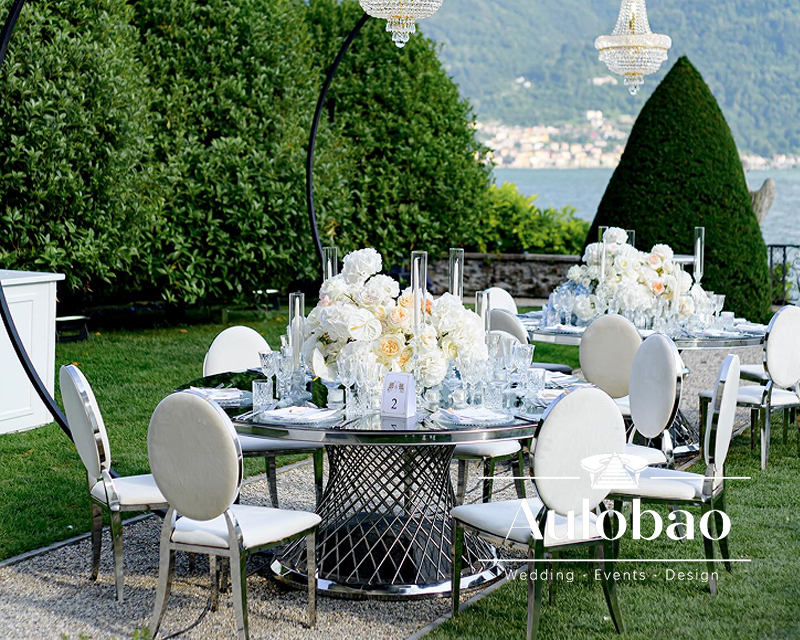Outdoor weddings are a beautiful way to celebrate your love, surrounded by nature and the fresh air. Whether you’re dreaming of a garden ceremony, a beachside reception, or a rustic barn wedding, planning an outdoor wedding comes with its own set of challenges and rewards. Here’s a step-by-step guide to help you plan an outdoor wedding that is as smooth as it is stunning.

1. Choose the Right Location
The first step in planning an outdoor wedding is choosing the perfect location. Think about the season, the vibe you want to create, and the practicality of the location. Some popular outdoor wedding locations include:
- Gardens or Botanical Gardens: Perfect for spring or summer weddings, these locations offer lush greenery and beautiful flowers.
- Beaches or Lakesides: Ideal for couples who love the idea of a tranquil, natural backdrop.
- Vineyards or Farms: Rustic and elegant, these spaces work well for fall weddings, offering open fields and vineyards.
- Public Parks: Affordable and accessible, public parks are a great option if you’re looking for a more relaxed or budget-friendly setting.
2. Secure the Necessary Permits
Many outdoor venues, especially public spaces, require permits for events like weddings. Make sure to check with local authorities or venue managers about any permits needed for holding an event on the property. Don’t forget to also ask about insurance requirements, especially in case of inclement weather or damage to the venue. Be proactive about this early in your planning to avoid last-minute surprises.
3. Plan for Weather
One of the most important aspects of planning an outdoor wedding is preparing for any type of weather. The weather can be unpredictable, and while sunny skies might be perfect one moment, it could rain unexpectedly the next. Here’s how to plan:
- Have a backup plan: If you’re planning a garden ceremony, consider having an indoor venue nearby or renting a tent that can be quickly set up in case of rain. Many venues offer covered areas that can act as a backup.
- Consider the season: Take into account the temperatures of the season you’re getting married in. Summer weddings may require shade and fans, while a winter wedding could need heaters and cozy blankets.
- Check the weather forecast: While the weather can never be predicted with total certainty, having an idea of what to expect as your wedding date approaches will allow you to prepare properly.
4. Choose Outdoor-Friendly Wedding Decor
Outdoor settings are naturally beautiful, but you’ll still want to add your personal touch to the space. When choosing decor, remember that certain elements may not work well outdoors due to wind or uneven terrain.
- Flower arrangements: Opt for flowers that can withstand the elements. If you’re having a wedding in a hot climate, go for more resilient blooms like orchids, sunflowers, or dahlias.
- Furniture: Depending on your venue, you may need to rent chairs, tables, and linens. Keep in mind that some outdoor surfaces can be uneven, so choose sturdy, flat furniture. You can even have lounge areas with cushions or vintage couches for a more relaxed vibe.
- Lighting: Outdoor lighting can be magical when done right. Use string lights, lanterns, candles, or chandeliers to create a romantic atmosphere. Just be sure to plan for how the lighting will be powered—battery-operated or solar options are often ideal for outdoor spaces.
5. Consider Comfort for Your Guests
Outdoor weddings can be a little more challenging for your guests, so make sure to provide them with the comfort they need to enjoy the day:
- Provide shade and seating: If your wedding is during a hot time of year, consider placing umbrellas, tents, or fans around the venue. If it’s cool, make sure there are cozy blankets or heaters available for warmth.
- Ensure accessibility: Make sure that your outdoor venue is accessible for all guests, especially those with mobility issues. Have clear paths, ramps, or seating areas where needed.
6. Set the Right Tone with Music and Sound
Outdoor venues can have issues with sound, so make sure you have the right equipment to ensure guests can hear the vows, speeches, and music clearly. You may need to rent a sound system or hire a professional DJ or sound technician who can handle the acoustics of an outdoor environment.
7. Prepare for Bugs and Critters
Depending on your location and the time of year, bugs and wildlife might be a concern. If you’re having an evening wedding, mosquitoes could become a problem, so think about ways to manage this:
- Insect repellent: Consider offering guests small bottles of bug spray or candles that ward off mosquitoes (citronella candles work great!).
- Clear the area of pests: If your venue has an issue with pests, talk to the venue coordinator about using non-toxic pest control before the event to keep the space safe.
8. Make the Menu Seasonal and Refreshing
One of the perks of an outdoor wedding is the ability to incorporate fresh, seasonal food into your menu. Take advantage of the seasonality of your wedding date by selecting ingredients that are available and perfect for outdoor events:
- Farm-to-table dining: Partner with local caterers who can provide fresh, in-season dishes.
- Barbecues, food trucks, or picnic-style dining: These types of casual dining options work well for outdoor events and can be a fun, interactive element to the reception.
- Refreshments: Provide cool drinks and refreshing options for your guests, especially if it’s a hot day. Lemonade, iced tea, and a signature cocktail can help guests beat the heat.
9. Set Up Restrooms (If Necessary)
If your outdoor venue doesn’t have on-site bathrooms, you’ll need to rent portable restrooms. Be sure to choose luxury restroom trailers to provide a comfortable experience for your guests. Some high-end options include air conditioning, clean facilities, and even small sinks for handwashing.
10. Get the Right Wedding Vendors
The beauty of an outdoor wedding is that it allows for a lot of flexibility with your vendors. From catering to flowers, make sure you hire vendors experienced with outdoor events. They will know how to handle logistical challenges and will have the equipment and expertise to make your day seamless.
Conclusion
Planning an outdoor wedding involves more preparation than a traditional indoor event, but the natural beauty and freedom it offers make it worth the effort. By choosing the right location, planning for any weather, ensuring comfort for your guests, and adding your own personal touches, you can create an unforgettable outdoor celebration. With careful planning, your outdoor wedding will be a stunning and memorable experience for both you and your guests.
About Us
We have been doing wedding furniture for 16 years. We are professional in the collocation of all kinds of wedding furniture. We also have a 3D design team, which can design different scenes for you. If you are interested, please pay attention to our website and feel free to contact us.
——————————————————————————————————————–
IF YOU INTERESTED IN OUR WEDDING AND EVENT FURNITURE
Choose Aulobao furniture, which will make you comfortable, and satisfied.
Welcome to contact us to get the latest product catalog and price list!
Please follow our Instagram or Pinterest or Tiktok to get more latest news.
![]()

